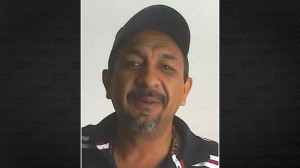
03/01/15 (written by cmolzahn) — Following an extended period of intelligence gathering, Mexico’s Federal Police (Policía Federal, PF) on Friday, February 27 arrested Knights Templar Organization (Caballeros Templarios, KTO) leader Servando Gómez Martínez, “La Tuta,” at a house in Morelia, Michoacán, as reported by Mexico’s Attorney General’s Office (Procuraduría General de la República, PGR). Arrested alongside Gómez were his girlfriend, María Antonieta Luna Ávalos (27), and seven of Gómez’s bodyguards. The same day, a separate operation in Mérida, Yucatán captured Gómez’s brother, Flavio Gómez Martínez, the alleged KTO financial chief.
Interior Minister Miguel Ángel Osorio Chong classified La Tuta’s capture as “the most important objective in the battle against organized crime, the detention of the most sought-after criminal in Mexico.” After La Tuta’s capture, National Security Commissioner Monte Alejandro Rubido said that the investigation leading to the arrest began in mid-2014, when authorities were able to identify several people acting as intermediaries between Gómez and members of his family. In September, Rubido said, investigators were able to identify an individual within Gómez’s inner circle, a messenger who communicated orders from Gómez to his area chiefs. On February 2, investigators saw this man and several others enter a home in Morelia, where La Tuta was presumably celebrating his birthday. The same group was identified on February 27 at the same home, upon which Special Forces were notified, and La Tuta was detained as he left the house, without shots being fired. Gómez’s arrest makes ten leaders of major criminal organizations arrested during the past six years, with six of those falling under the Peña Nieto administration, with the highest-priority cartel leader remaining being Ismael “El Mayo” Zambada of the Sinaloa Cartel.
Gómez, formerly an elementary school teacher, had climbed the ranks of the now-defunct La Familia Michoacana criminal organization and, following the disintegration of that group in 2010, joined Nazario Moreno, also currently in government custody, to form the KTO. The new organization retained the pseudo-religious pretext of its predecessor, while branching out into activities including extortion and infiltration into Michoacán’s mining and agricultural sectors. The group’s presence in Michoacán reached its pinnacle in early 2013, when vigilante groups (grupos de autodefensa) emerged in the Tierra Caliente region. Initially sparked by embattled lime producers, the groups decried the government’s failure to address the aggressive tactics of the KTO, which had drastically extended its reach across the state, including Mexico’s second largest port in Lázaro Cárdenas.
It is often the case that when the head of a criminal organization is captured, violence ensues as lower-ranking members fight among themselves for control of the territories of influence, particularly in cases of newer, less-disciplined groups. Some national security experts believe that this will be the case following the arrest of La Tuta, whose group at one time influenced local politics, controlled sectors of the economy, and otherwise made its presence known through violence, threats, and extortion in municipalities across Michoacán. Gerardo Rodríguez, national security and terrorism professor at the Collective of Analysis of Security with Democracy (Colectivo de Análisis de la Seguridad con Democracia, Casede), said that Gómez’s arrest was the “cherry on the cake” that the Peña Nieto administration needed to be able to draw the “low intensity war” in Michoacán to a close. Javier Oliva, a national security expert at Mexico’s National Autonomous University, said that Gómez’s capture is good news for the government, as well as the citizenry, and particularly for the electoral process in Michoacán. Meanwhile Jorge Chabat, a professor and researcher in the international studies division of the Center for Economic Investigation and Teaching (Centro de Investigación y Docencia Económicas, CIDE), agrees that the arrest of La Tuta is a positive development in the short term, but must not distract from the fact that there are long term, structural problems of public security that need to be addressed. He added his doubts about the likelihood of Michoacán’s security situation improving. While recognizing La Tuta’s arrest as an important step, he said that other criminal groups would likely attempt to fill the void. Gerardo Rodríguez foresees a process of fragmentation within the KTO, accompanied by a strengthening of the KTO’s principal rival, the Jalisco New Generation Cartel (Cartel Jalisco Nueva Generación, CJNG), as well as attempts by the Gulf Cartel (Cartel del Golfo, CDG) and the Zetas to try to retake lost territory, including the port of Lázaro Cárdenas. Oliva pointed out that this process – particularly the increased activity of the Cartel Jalisco Nueva Generación – had already begun during the time that La Tuta was occupied with avoiding the latest federal operation to capture him. Justice in Mexico Project’s David Shirk warns that it would be a mistake to conclude that the KTO is dismantled after Gómez’s arrest given the staying power it has exhibited thus far, with roots dating back to the 1980s and 1990s.
Sources:
Muedano, Marcos. “’La Tuta’: tuve que tomar el poder en Michoacán.” El Universal. February 28, 2015.
“Captura de La Tuta no reduce el narcotráfico, dicen expertos.” La Jornada. March 1, 2015.




